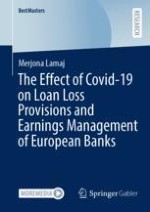2023 | OriginalPaper | Buchkapitel
2. IFRS 9 and the Expected Credit Loss Model
verfasst von : Merjona Lamaj
Erschienen in: The Effect of Covid-19 on Loan Loss Provisions and Earnings Management of European Banks
Verlag: Springer Fachmedien Wiesbaden
Aktivieren Sie unsere intelligente Suche, um passende Fachinhalte oder Patente zu finden.
Wählen Sie Textabschnitte aus um mit Künstlicher Intelligenz passenden Patente zu finden. powered by
Markieren Sie Textabschnitte, um KI-gestützt weitere passende Inhalte zu finden. powered by
